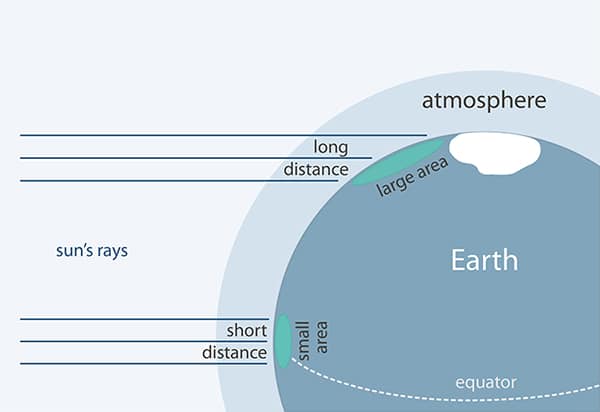Antarctica is the coldest place on Earth. The coldest temperature ever recorded there was −128.6°F (−89.2°C) at Vostok Station in 1983. In winter, temperatures can drop below −76°F (−60°C), and in summer, coastal areas may reach 14°F (−10°C), while inland areas remain much colder.
The coldest part of Antarctica is the Antarctic Plateau, which rises up from the coastal plains to an average elevation of 3,000 m (9,800 ft). On the Antarctic Plateau, winter temperatures regularly fall below -60°C (-76°F).
If you’re thinking of visiting Antarctica and the thought of the cold gives you the shivers, never fear! Travellers to the Antarctic Peninsula can expect to enjoy more moderate conditions when the weather in Antarctica is as warm as 10°C (50°F) when we visit in summer.
What is the lowest temperature ever recorded in Antarctica?
The record for the lowest temperature ever recorded on the surface of the Earth was at Vostok Station in Antarctica. In 1983, scientists recorded an incredible low of -89.2°C (-128.6°F) at the Russian research station, located roughly 1,300 km (807 mi) from the Geographic South Pole.
Amazed by this impressively low temperature, scientists were curious whether this was the coldest place on earth, or if there might be even colder places where no human has dared to tread.
Over the next 35 years, technological advancements changed the way scientists monitor the weather. Today, you don’t have to suit up and walk out to a weather station in sub-zero temperatures to check how cold it is. Instead, scientists use data collected by satellites far above the earth's surface, and in 2013 they discovered the coldest place on earth. After analysing 32 years of data, scientists measured tiny pockets of air close to the surface of the East Antarctic Ice Sheet at a staggering -93.3°C (-135.9°F). Read the article here.
What is the highest temperature ever recorded in Antarctica?
We know that Antarctica can be very cold, but how warm can it get? The Antarctic Peninsula, known as Antarctica’s ‘banana belt’, can be quite mild, with annual averages around -10°C (14°F) and summer temps reaching a balmy 10°C (50°F).
The highest temperature ever recorded in Antarctica was at Seymour Island, located on the northeast Antarctic Peninsula. On February 9, 2020, the mercury hit a balmy 20.75°C (69.3°F), a record high which, if verified by the World Meteorological Organisation (WMO)*, represents a jump of 3.25°C (37.85°F) in 5 years. This follows another record high measured three days earlier at the Argentinian research base Esperanza, also located on the northern Antarctic Peninsula. On February 6, 2020, temperatures at Esperanza reached 18.3°C (64.9°F).
The hottest Antarctic day verified by the WMO was also at Esperanza, on March 24, 2015, with a temperature of 17.5°C (63.5 °F).
Natural climate variability and human-induced climate change both have an impact on temperatures in Antarctica. Over the past 50 years the Antarctic Peninsula in particular has seen rapid warming, with an increase in average annual air temperatures of around 2.8 °C (37°F), more than any other landmass in the southern hemisphere. Most scientists attribute this upward trend to anthropogenic climate change.
What is the average temperature in Antarctica?
Antarctica has two seasons, summer and winter, and the average temperature varies dramatically.
How cold is Antarctica in summer?
The sun doesn’t set during summer but Antarctica the continent lives up to its chilly reputation. Summer maximums across most of the continent rarely exceed -20°C (-4°F). The only exception is the coast, where highs occasionally rise above 0°C (32°F), particularly on the Antarctic Peninsula.
How cold is Antarctica in winter?
In winter, sea ice envelops the continent and Antarctica is plunged into months of darkness. The monthly mean temperature at the South Pole in winter hovers around -60°C (-76°F). Along the coast, winter temperatures range between −15 and −20 °C (-5 and −4 °F).
How does the windchill factor affect temperatures in Antarctica?
Antarctica is known for being the windiest continent on earth, and the wind not only makes air temperatures feel colder, but also increases the risk of frostbite and hypothermia.
Windchill is a measure of the air temperature plus the effect of wind. When you read the weather forecast, the ‘feels like’ temperature usually takes windchill into account.
Why does the wind make temperatures feel colder? Humans have a very thin layer of warm air around us, warmed by our bodies. When the wind picks up it strips this layer away, creating a feeling of cold. The stronger the wind, the stronger this effect. If there’s no wind, the temperature we feel will be close to the actual temperature. A slight breeze will make it feel a bit colder, and a strong wind even colder.
Although the air temperature may be only -1°C (30°F), a wind of 16 km/h (10mph) makes it feel like -6°C (21°F). If the wind picks up to 64 km/h (40mph) it will feel more like -10°C (13°F).
Why is Antarctica so cold?
There are a few reasons that Antarctica is the coldest place on earth:
1.Sunlight
Due to its position over the South Geographic Pole, Antarctica experiences 6 months of darkness each year. When the sun does reach the continent, it is not as strong as it is in other places on Earth.
At the equator, the sun takes the most direct, shortest route through the atmosphere, passing through at roughly a right angle. However at the poles the sun takes a more oblique angle, which means that it has to penetrate through more atmosphere to reach the earth’s surface. By the time it arrives, its strength is somewhat diminished.
[caption id="attachment_9452" align="aligncenter" width="600"] Antarctica is so cold due to its position over the South Geographic pole.[/caption]
Antarctica is so cold due to its position over the South Geographic pole.[/caption]2. Altitude
Antarctica is the ‘highest’ continent on Earth with an average altitude of about 3,000 m (9,800 ft). This contributes to its coldness, as temperatures decrease with altitude.
3. Wind
Antarctica is also the windiest continent on earth, and increased wind makes cold air temperatures feel even colder through windchill.
4. Reflective surfaces
Ice and snow are highly reflective, radiating most heat and light back out to space, keeping the air above them relatively cool.
How does the temperature in Antarctica compare to other cold places?
How cold is Antarctica compared to Canada, the Arctic . . . or a fridge? It can be difficult to imagine how super-cold temperatures feel - particularly if you’re from a country like Australia where the mercury rarely plunges below 0°C (32°F)!
As a guide, if you put your hand in your home freezer, you’re feeling a temperature of about -15°C (5°F). Commercial freezers and cool rooms are generally kept at a chilly -17°C (0°F).
Top 5 Coldest Places on Earth
- Dome Fuji, Antarctica -93.3°C (-135.9°F).
- Vostok Station, Antarctica -89.2°C (-128.6°F)
- Amundsen-Scott South Pole Station, Antarctica -82.8°C (-117°F)
- Dome Argus, Antarctica -82.5°C (-116°F)
- Mt McKinley, Alaska -73.8°C (-100°F)
Antarctica takes the title for the top 4 coldest places on earth, but Russia and Greenland aren’t far behind Alaska, with lows of -69.8°C (-93°F) and -69.4°C (-92.9°F) respectively. Antarctica may be cold, but it’s far from the coldest environment humans have endured. On spacewalks, astronauts experience conditions as cold as -121°C (-185.8°F)!
Like to keep learning about Antarctica? You can read more about what makes this incredible continent so unique here.
Are you ready to brave the cold? Find out what kind of weather you can expect on your Antarctic expedition cruise here. And if you'd like to find out more about our Antarctic trips you can browse our Antarctic cruises or contact our expedition experts for more information.
*At the time of writing (February 14, 2020), the World Meteorological Organisation (WMO) committee, which has verified previous temperature records in Antarctica, had not yet verified the new records set in February, 2020. However, the Guardian reports that according to Professor James Renwick, a climate scientist at Victoria University of Wellington, the February 6, 2020 record is valid, the temperature station is well-maintained, and the WMO committee will most likely meet again to verify this new record. We are awaiting more information about the record on Seymour Island.

Words by Nina Gallo, Aurora Expeditions' historian and certified PTGA polar guide.
Nina has been drawn to the polar regions since her first otherworldly experience of the midnight sun in 2002. Since then she has spent time in far northern Canada, the Himalayas, the Alps and deserts in America and Australia, always seeking out quiet, wild corners to explore. She feels immensely privileged to travel to these places and shares her passions for the natural world, human stories and adventure with all the wonderful people she meets. Nina is the author of Antarctica, published by Australian Geographic in September 2020.


